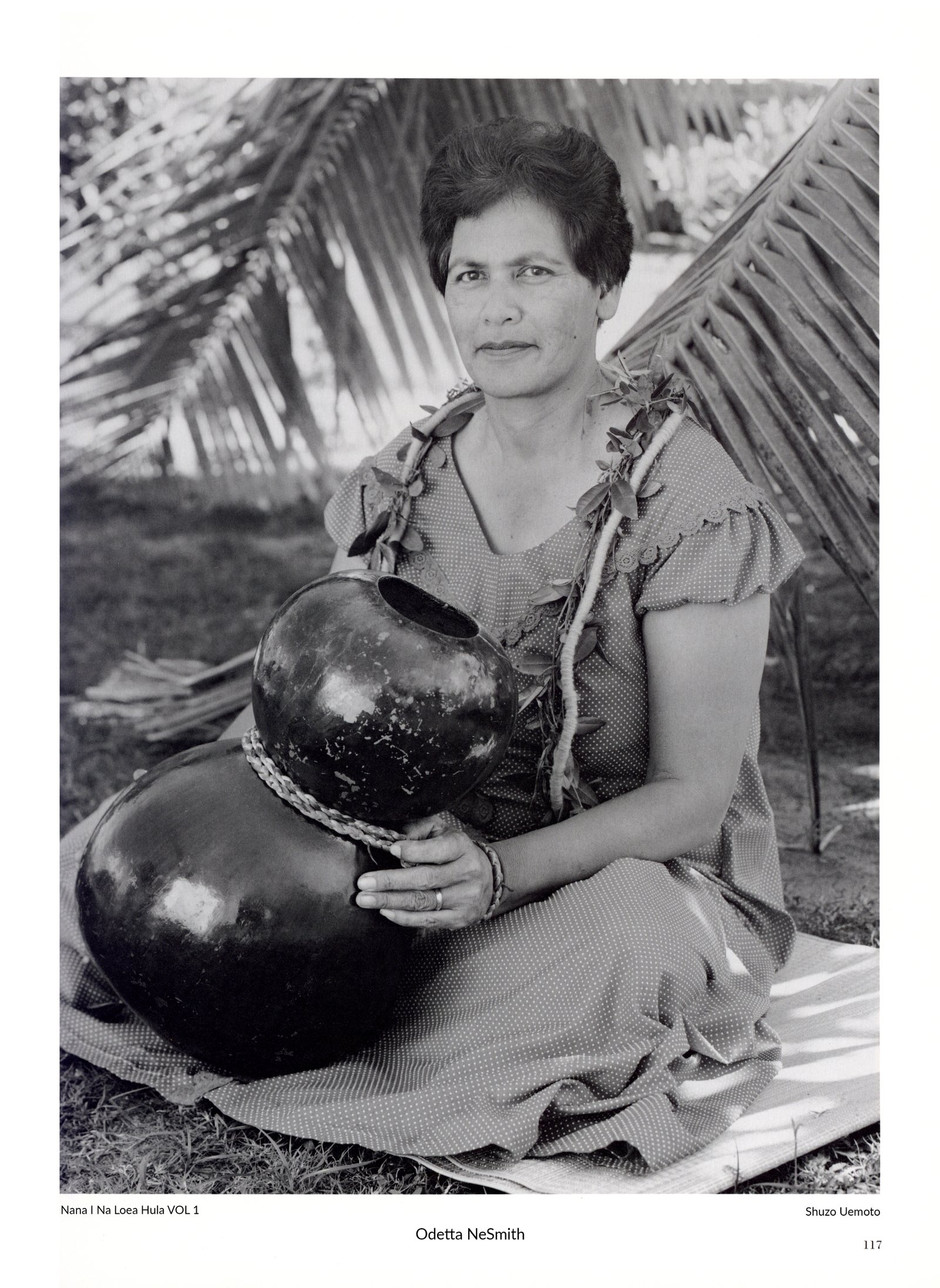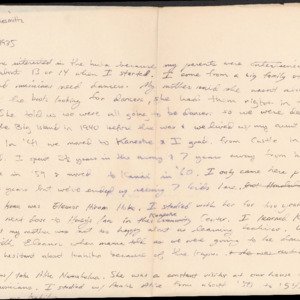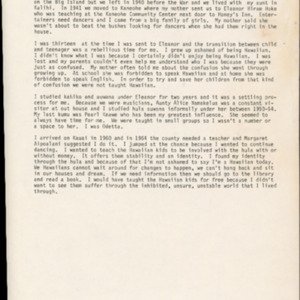Odetta NeSmith
Title
Odetta NeSmith
Description
Odelta NeSmith
Born on the Big Island of Hawaiʻi and raised in Kalihi, O‘ahu, Odetta NeSmith has taught on Kaua‘i for nineteen years.
I think we have to appreciate that the hula has been passed down to us through the hundreds of years and that it already has been altered and changed during those hundreds of years. We should let the new kumu take their turn in trying to improve it. Maybe what they’re doing is not an improvement but they are recording the modern influences of their time and I cannot believe our ancestors did not do the same when the kahiko was passed to them.
I became interested in the hula because my parents were entertainers. I was born on the Big Island but we left in 1940 before the war and we lived with my aunt in Kalihi. In 1941 we moved to Kāne‘ohe where my mother sent us to Eleanor Hiram Hoke who was teaching at the Kāne‘ohe Community Center next door to Honey’s Inn. Entertainers need dancers and I came from a big family of girls. My mother said she wasn’t about to beat the bushes looking for dancers when she had them right in the house.
I was thirteen at the time I was sent to Eleanor and the transition between child and teenager was a rebellious time for me. I grew up ashamed of being Hawaiian. I didn’t know what I was because I certainly didn’t enjoy being Hawaiian. I was lost and my parents couldn’t even help me understand who I was because they were just as confused. My mother often told me about the confusion she went through growing up. At school she was forbidden to speak Hawaiian and at home she was forbidden to speak English. In order to try and save her children from that kind of confusion we were not taught Hawaiian.
I studied kahiko and ‘auwana under Eleanor for two years and it was a settling process for me. Because we were musicians, Aunty Alice Nāmakelua was a constant visitor at our house and I studied hula ‘auwana informally under her between 1950 and 1954. My last kumu was Pearl Keawe who has been my greatest influence. She seemed to always have time for me. We were taught in small groups so I wasn’t a number or a space to her. I was Odetta.
I arrived on Kaua‘i in 1960 and in 1964 the county needed a teacher and Margaret ‘ Aipōalani suggested I do it. I jumped at the chance because I wanted to continue dancing. I wanted to teach the Hawaiian kids to be involved with the hula with or without money. It offers them stability and an identity. I found my identity through the hula and because of that I’m not ashamed to say I’m a Hawaiian today. We Hawaiians cannot wait around for changes to happen, we can’t hang back and sit in our houses and dream. If we need information then we should go to the library and read a book. I would have taught the Hawaiian kids for free because I didn’t want to see them suffer through the inhibited, unsure, unstable world that I lived through.
Born on the Big Island of Hawaiʻi and raised in Kalihi, O‘ahu, Odetta NeSmith has taught on Kaua‘i for nineteen years.
I think we have to appreciate that the hula has been passed down to us through the hundreds of years and that it already has been altered and changed during those hundreds of years. We should let the new kumu take their turn in trying to improve it. Maybe what they’re doing is not an improvement but they are recording the modern influences of their time and I cannot believe our ancestors did not do the same when the kahiko was passed to them.
I became interested in the hula because my parents were entertainers. I was born on the Big Island but we left in 1940 before the war and we lived with my aunt in Kalihi. In 1941 we moved to Kāne‘ohe where my mother sent us to Eleanor Hiram Hoke who was teaching at the Kāne‘ohe Community Center next door to Honey’s Inn. Entertainers need dancers and I came from a big family of girls. My mother said she wasn’t about to beat the bushes looking for dancers when she had them right in the house.
I was thirteen at the time I was sent to Eleanor and the transition between child and teenager was a rebellious time for me. I grew up ashamed of being Hawaiian. I didn’t know what I was because I certainly didn’t enjoy being Hawaiian. I was lost and my parents couldn’t even help me understand who I was because they were just as confused. My mother often told me about the confusion she went through growing up. At school she was forbidden to speak Hawaiian and at home she was forbidden to speak English. In order to try and save her children from that kind of confusion we were not taught Hawaiian.
I studied kahiko and ‘auwana under Eleanor for two years and it was a settling process for me. Because we were musicians, Aunty Alice Nāmakelua was a constant visitor at our house and I studied hula ‘auwana informally under her between 1950 and 1954. My last kumu was Pearl Keawe who has been my greatest influence. She seemed to always have time for me. We were taught in small groups so I wasn’t a number or a space to her. I was Odetta.
I arrived on Kaua‘i in 1960 and in 1964 the county needed a teacher and Margaret ‘ Aipōalani suggested I do it. I jumped at the chance because I wanted to continue dancing. I wanted to teach the Hawaiian kids to be involved with the hula with or without money. It offers them stability and an identity. I found my identity through the hula and because of that I’m not ashamed to say I’m a Hawaiian today. We Hawaiians cannot wait around for changes to happen, we can’t hang back and sit in our houses and dream. If we need information then we should go to the library and read a book. I would have taught the Hawaiian kids for free because I didn’t want to see them suffer through the inhibited, unsure, unstable world that I lived through.
Citation
“Odetta NeSmith,” Nā Kumu Hula Archive, accessed September 16, 2025, https://nakumuhula.org/archive/items/show/76.


